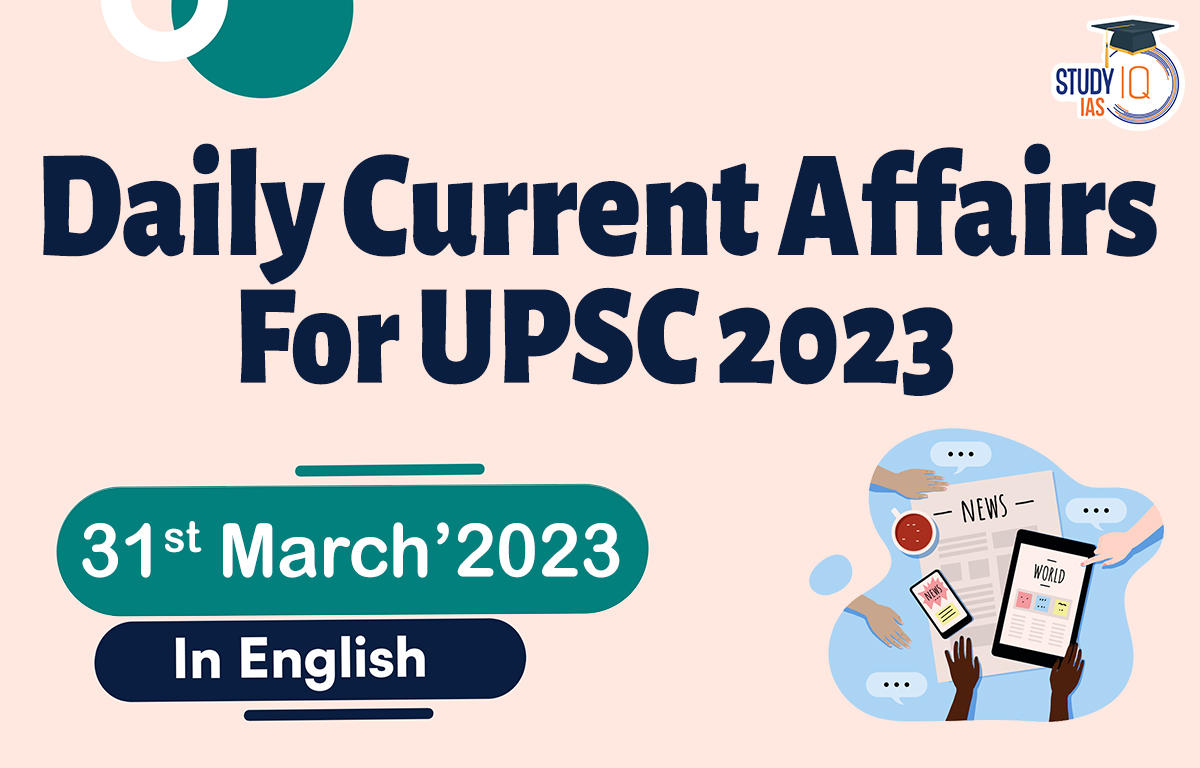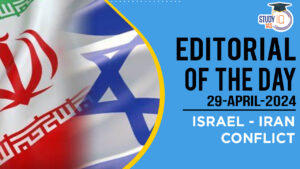Daily Current Affairs for UPSC 2023
Q) Recently seen in news, the term ‘capital market deepening’ is related to which one of the following?
- Development of new capital market instruments
- Establishing capital markets in low-income countries
- Interlinking the banking sector and capital markets
- Increasing the liquidity and accessibility of capital markets
Daily Current Affairs for UPSC – 30 March 2023
Explanation:
- Option (4) is correct: Capital market deepening refers to the process of increasing the liquidity, efficiency, and accessibility of a country’s capital markets. It involves developing financial systems and institutions that support a wider range of financial instruments, increasing participation of investors, and expanding the range of financial services available to them. The need for capital market deepening in India arises as the governments have limited resources to finance their own infrastructure and development projects. Capital market deepening can help bridge this gap by providing an alternative source of long-term financing. A deep and liquid capital market can help spur economic growth by facilitating the allocation of capital to productive investments. A deep and liquid capital market can help attract foreign investors by providing them with a range of investment options and ensuring the stability of the financial system. Capital market deepening can help diversify a country’s financing options beyond traditional bank lending, allowing companies to access a wider range of funding sources.
Q) With reference to ‘Vaikom satyagraha’, consider the following statements:
- It aimed at opposing the British government on the provisions of the Rowlatt Act, 1919.
- Congress leaders T.K. Madhavan and K.P. Kesava Menon were associated with this satyagraha.
- This movement also supported the oppressed castes’ right to move on public roads in the vicinity of temples.
Which of the statements given above is/are correct?
- 1 and 2 only
- 2 and 3 only
- 1 and 3 only
- 1, 2 and 3
Explanation:
- Statement 1 is incorrect but statement 2 is correct: Vaikom Satyagraha was a historic non-violent movement against untouchability and caste discrimination in the country. The Satyagraha took place between March 30, 1924 and November 23, 1925 and also marked the start of temple entry movements across India. The movement was spearheaded by Congress leader T.K. Madhavan, as an opposition against social injustice. Apart from Madhavan, K.P. Kesava Menon (then secretary of Kerala Congress) and Congress leader and educationist K. Kelappan are considered the pioneers of the Vaikom Satyagraha movement. ‘Periyar’ E.V. Ramasamy was requested to lead the campaign. Periyar mobilized support from nearby areas through his speeches. He was arrested and imprisoned for one month before being arrested again in July 1924. He was sentenced to rigorous imprisonment for four months. Members of forward castes marched from Travancore till the royal palace at Tiruvananthapuram, in a show of solidarity for the social reform. The Akalis (Sikhs) from Punjab gave their support by opening a community kitchen (langar) for the volunteers. Christian and Muslim leaders also supported the movement. Gandhiji was not in favour of this development, as he wanted the agitation to be a “Hindu affair”. Religious leaders such as Chattampi Swamikal and Sree Narayana Guru gave support to the movement. Mahatma Gandhi, who till now had only provided guidance to the movement, arrived at Vaikom in March 1925. He met with the Regent Maharani to arrive at a compromise and settle the issue once for all.
- Statement 3 is correct: The Tamil Nadu government is planning to hold year-long events to commemorate the Vaikom Satyagraha. On November 23, 1925, three roads, excluding Eastern entrance road to the Vaikom temple, were thrown open to all castes. The Vaikom Satyagraha was officially withdrawn on November 30, 1925 after consultations between Gandhi and the then police commissioner of Travancore. In 1928, oppressed castes were given the right to move on public roads in the vicinity of all temples in Travancore. The movement paved the way for the historic Temple Entry Proclamation by the Maharaja of Travancore, which lifted the age-old ban on the entry of marginalized castes into Travancore temples.
Q) Consider the following statements about Goods and Services Tax Appellate Tribunal (GSTAT):
- GSTAT is a quasi-judicial body that resolves disputes regarding the interpretation of the GST laws.
- A person not satisfied with the decision passed by GSTAT cannot appeal to the High Court of India.
- The GSTAT can impose penalties but cannot revoke the registration of a business.
Which of the statements given above is/are not correct?
- 1 and 2 only
- 3 only
- 2 and 3 only
- 1, 2 and 3
Explanation:
- Statement 1 is correct but statement 2 is incorrect: Section (109) of the Goods and Service Tax Act, 2017 (CGST Act) mandates the constitution of a Goods and Services Tax (GST) Appellate Tribunal (GSTAT) and its Benches. The Appellate Tribunal under GST is a quasi-judicial body that has been established to provide a platform for the resolution of disputes that arise between businesses, individuals, and the government regarding the implementation and interpretation of the GST laws. The GST Appellate Tribunal (GSTAT) is the second appeal forum under GST. The National Appellate Tribunal is also the first common forum to resolve disputes between the centre and the states. Under GST, if a person is not satisfied with the decision passed by any lower court, an appeal can be raised to a higher court, the hierarchy for the same is as follows (from low to high):
- Adjudicating Authority
- Appellate Authority
- Appellate Tribunal
- High Court
- Supreme Court
Thus Appellate Tribunal’s orders can be challenged before High Court.
- Statement 3 is incorrect: As per the Code of Civil Procedure, 1908, the GST Appellate Tribunal holds the same powers as the court and is deemed Civil Court for trying a case. It has been granted the powers to hear appeals and to pass orders and directions, including those for the recovery of amounts due, for the enforcement of its orders, and for the rectification of mistakes. It also has the power to impose penalties, revoke or cancel registrations, and take such other measures as may be necessary to ensure compliance with the GST laws. Its framework may permit the resolution of disputes involving dues or fines of less than Rs. 50 lakhs by a single-member bench.
Q) With reference to ‘Photo Voltaic (PV) Waste’, consider the following statements:
- The PV waste contains heavy metals such as antimony and cadmium.
- At present, there is no regulatory body to measure and report solar photovoltaic waste in India.
- As per the International Renewable Energy Agency, India is expected to be the largest producer of photovoltaic waste by 2050.
Which of the statements given above is/are correct?
- 1 and 2 only
- 2 and 3 only
- 1 and 3 only
- 3 only
Explanation:
- Statements 1 and 2 are correct: Photo Voltaic Waste is the electronic waste (e-waste) generated by discarded solar panels and Photo-voltaic (PV) devices. Photovoltaic (PV) devices contain semiconducting materials that convert sunlight into electrical energy. A single PV device is known as a cell, and these cells are connected in chains to form larger units known as modules or panels. Although up to 90% of the components are recyclable, many PV modules contain heavy metals such as cadmium, copper, lead, antimony or selenium, and when they are taken out of service or broken, they may be classified as hazardous waste. The market to repurpose or reuse recycled photovoltaic waste in India is minuscule. There is a lack of suitable incentives and schemes in which businesses can invest. There is no regulatory body to measure, monitor, and report solar photovoltaic waste too.
- Statement 3 is incorrect: India has the world’s fourth highest solar PV deployment. The installed solar capacity was nearly 62GW in November 2022. This will lead to huge amount of solar PV waste in India. India has ambitious solar target of 280 GW by 2030. According to a report by the National Solar Energy Federation of India, India could generate over 34,600 tonnes of cumulative solar waste by 2030. According to the International Renewable Energy Agency, India is expected to be one of the top five photovoltaic-waste creators by 2050.
Q) Consider the following statements about National Policy for Rare Diseases, 2021:
- It allows voluntary crowd funding treatment by setting up a digital platform.
- The policy aims to set up’ Centres of Excellence’ with one-time grant of up to Rs. 5 crore for upgrading of diagnostic facilities.
Which of the statements given above is/are correct?
- 1 only
- 2 only
- Both 1 and 2
- Neither 1 nor 2
Explanation:
- Statement 1 is correct: National Policy for Rare Diseases, 2021 categorizing rare diseases:
- Group 1: Disorders treatable through one-time curative treatment. Individuals suffering from rare diseases listed under Group 1 will be provided financial support of up to Rs. 20 lakh. The benefits will be extended to 40% of the population, who are eligible under Pradhan Mantri Jan Arogya Yojana.
- Group 2: Need long term or lifelong treatment.
- Group 3: Definitive treatment is available but challenges occur in form of very high cost and lifelong therapy.
- It also allows voluntary crowd funding treatment by setting up a digital platform.
- Statement 2 is correct: National Policy for Rare Diseases, 2021 plans to set up eight ‘Centres of Excellence’ at designated places for prevention and treatment of rare diseases. They will be provided one-time grant of up to Rs. 5 crore for upgradation of diagnostics facilities. Rare disease is a life-threatening condition that affects a small number of people compared with other existing diseases. Different countries have different definition. India classifies the disease as rare if the prevalence rate in population is 6% to 8%. Currently, there are about 6000 to 8000 rare diseases. However, 80% of all patients are affected by approximately 350 rare diseases. About 95% rare diseases do not have approved treatment and less than 1 in 10 patients receive disease-specific treatment. About 80% of rare diseases are genetic in origin and hence disproportionately impact children. In India, 72 to 96 million people are affected by rare diseases. Most of the patients do not reach adulthood due to the high mortality.


 Current Affairs 29th April 2024 for UPSC...
Current Affairs 29th April 2024 for UPSC...
 Towards Green Growth, Impact of Climate ...
Towards Green Growth, Impact of Climate ...
 Editorial of the day (29th Apr): Israel ...
Editorial of the day (29th Apr): Israel ...

















